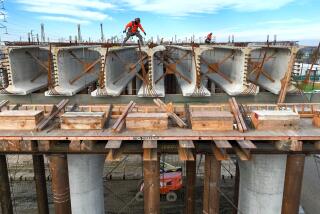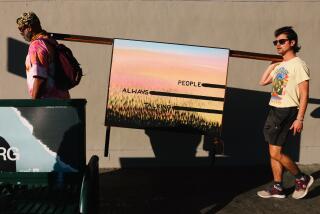Between a rock and LACMA, it’s a hard place
The object: A 340-ton, 211/2-foot-tall chunk of granite, sitting in a quarry in Riverside County.
The mission: Lift it and haul it to the Los Angeles County Museum of Art, on a 106-mile journey.
Degree of difficulty: High. Very high.
This is no ordinary rock. The massive boulder is supposed to form the centerpiece of artist Michael Heizer’s outdoor sculpture called “Levitated Mass,” part of a planned permanent display on the north side of LACMA’s Wilshire Boulevard campus.
If only the rock could really levitate. Moving it is turning out to be tougher than expected, and the museum, which was supposed to take delivery in August, now says the rock likely won’t leave the quarry until the end of December.
“The move ain’t gonna be a picnic,” says Rick Albrecht, the project’s logistics supervisor whose company, Emmert International, has moved nuclear generators and a 19th-century historic home, so he knows a thing or two about heavy lifting. “But the preparation is the biggest job.”
Here’s the plan. The big rock sits in Stone Valley quarry, a 90-acre wash of gray and brown framed by dusty, granite hillsides and Riverside’s Jurupa mountains. Truckers must wrangle the boulder from the quarry onto a 294-foot-long, modular, centipede-like “transporter,” which will carry it through the night on its journey across three counties.
Top speed? Seven miles per hour.
Work crews from 100 utility districts will accompany the rock to take down traffic signs, overhead wires and other obstacles, then reinstall them once the giant transporter moves on. A signal expert will move and then reinstate the traffic lights that otherwise would be mowed down like blades of grass by the transporter, which is nearly as wide as three freeway traffic lanes.
There will be flag crews to stop traffic and a security detail. And, of course, the requisite documentary film crew.
Once in place, the boulder will rest atop a 456-long, ramp-like slot in the ground through which visitors will pass, making it appear that the rock levitates above them. The whole project — cost of the rock, its transport and construction of the sculpture site — will cost up to $10 million, which the museum has raised from private donors, including Terry and Jane Semel, Bob Daly and Carole Bayer Sager.
It is, as LACMA director Michael Govan is fond of noting, a process not unlike that facing the ancient Egyptians when they built the pyramids.
But the Pharaohs didn’t have to contend with a thicket of bureaucracy. Even before they get underway, the movers must negotiate with city and county and state officials for the myriad permits required to cross jurisdictions — more than 100 in all.
And local officials are determining which roads and bridges are large enough and strong enough to withstand the weight. Permits are in flux for four cities, with Diamond Bar doing engineering studies on its portion of the proposed route.
“It’s intensive,” concedes Albrecht, something of a modern-day cowboy with a bushy mustache, silver hoop earring and a deep, above-the-neck-tan. He is standing in Stone Valley, eerily quiet but for the intermittent bleeping of a bulldozer and the occasional rumble of loose rock tumbling down quarry walls.
“Everyone has to be in agreement. It’s always changing. Then we re-route. The [permitting] process generally takes a year, and we have six months. So we’ve been fighting like crazy to get it done.”
Albrecht’s brother Mark, lead project manager at Emmert, is the Oz-like figure behind boardroom doors, negotiating with municipalities for permission to travel their roads. Rerouting, he says, sets off a domino effect of changes involving multiple crews, scheduling tangles, new test drives, yet more permits — and each time pushing back the rock’s leave date.
Meantime, the engineering feat that is the transporter raises its own set of obstacles.
“Try turning a vehicle like that,” Rick Albrecht says, pointing out that the transporter will often have to drive on the wrong side of the road to make a turn.
Which is why the rock will travel at night, on roads closed to traffic — a combined 1.2 million-pound load traveling so slowly that the journey will take nine days. The rock itself will be shrink-wrapped for protection and the vehicle illuminated by more than 800 feet of string lights for visibility.
Parking? “The middle of the road, the only place big enough,” Rick says. Multiple permits were needed to park the rock during the day.
Tim Culverwell is the green light, red light guy — literally. As a superintendent at LA Signal, he’ll have the laborious job of moving traffic signals.
“We’re gonna end up flashing, lifting and turning almost every traffic signal pole that we pass,” he says. “We’ve never had to go to this extreme on a load before; it’s up to a two-hour process per pole.”
If all this seems excessive, the artist’s assistant, Tim Cunningham, is quick to play devil’s advocate. “I’ve found it amusing from what I’ve read in the press about the expense, the naysayers. It’s as viable as any other public works project,” he insists. “And this is creating jobs above and beyond the aesthetic appeal — for Emmert, the riggers, the truckers, the utility guys working overtime — and the country needs jobs.”
Stephen Vanderhart, co-owner of the quarry, has found the experience a mixed blessing. The transporter which was built around the rock, sits smack in the middle of his mining area disrupting production. But what the quarry has lost in production, it’s gained in PR, Vanderhart says. Stone Valley gets about half a dozen calls a day from people asking if the rock has moved, and visitors stop by every week to gawk.
“It’s amazing; people who aren’t necessarily into art are excited about it because of the mechanics, the geology of it,” Vanderhart says.
The night the boulder begins its epic journey, Vanderhart plans to see it off with an open-air barbecue for about 300 people at the quarry, complete with a DJ and custom T-shirts as souvenirs.
What will the T-shirts say? “Big … Rock … Move!”
More to Read
The biggest entertainment stories
Get our big stories about Hollywood, film, television, music, arts, culture and more right in your inbox as soon as they publish.
You may occasionally receive promotional content from the Los Angeles Times.







